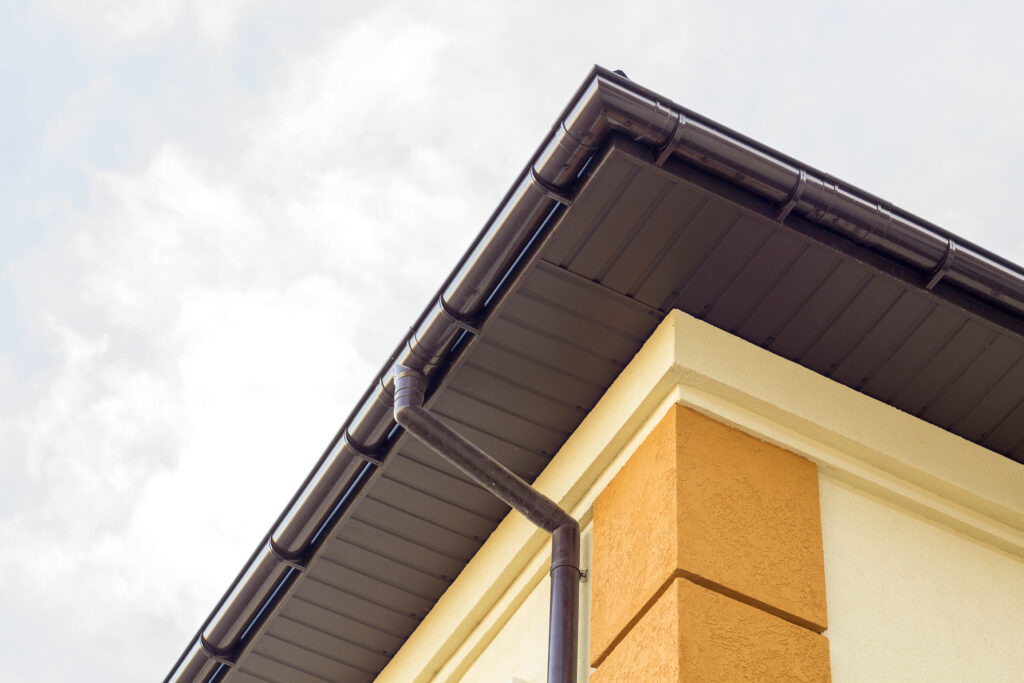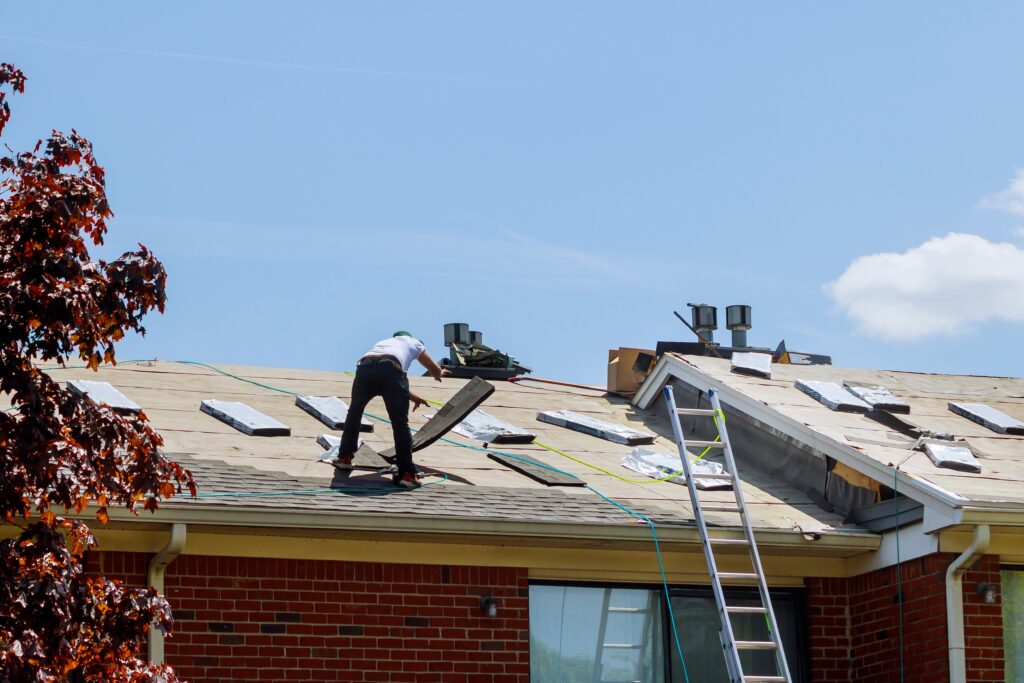1. Consider the Climate in Your Area
The climate where you live should be a major factor in your decision. Different gutter systems are designed to handle varying weather conditions:
Rainfall & Storms: If you live in an area that experiences heavy rainfall or storms, you’ll want a gutter system that can handle a large volume of water. Seamless gutters and larger downspouts are great choices for regions with frequent rain.
Snow & Ice: In colder climates, ice dams can form in gutters, causing damage. Gutter systems with heating elements or gutters that are properly pitched can help prevent this.
Windy Areas: Strong winds can easily blow leaves and debris into your gutters. Consider installing gutter guards or mesh covers if you live in a windy area to keep your gutters clean and free-flowing.
2. Choose the Material that Best Fits Your Budget and Style
There are several gutter materials to choose from, each offering distinct benefits and price points:
Aluminum: Lightweight, durable, and rust-resistant, aluminum gutters are one of the most popular and affordable options. They are available in a variety of colors to complement your home’s exterior.
Copper: For a more elegant, high-end option, copper gutters provide a timeless look. They are durable and naturally resist rust. However, they are more expensive than aluminum and require maintenance to maintain their appearance.
Vinyl: Vinyl gutters are another budget-friendly option. They are easy to install, lightweight, and resistant to rust, but they may not be as durable as aluminum or copper.
Steel: Steel gutters are incredibly durable and can withstand extreme weather conditions. They are a good option for areas with heavy rainfall or snow but may be prone to rust if not properly maintained.
Galvanized Steel: A more affordable alternative to stainless steel, galvanized steel gutters are strong but can rust over time if not properly maintained.
3. Choose Between Seamless vs. Sectional Gutters
Seamless Gutters are custom-made to fit your home’s dimensions without seams, which means fewer opportunities for leaks and clogs. They are more durable and require less maintenance compared to sectional gutters. Seamless gutters are also more aesthetically pleasing since they provide a clean, uniform appearance.
Sectional Gutters are pre-formed and come in sections that are connected together. They are easier to install and cost less upfront, but they are more prone to leaks and require more maintenance over time.
4. Determine the Right Size for Your Home
Gutters come in various sizes, typically measured by width (in inches). The size you choose depends on the roof area and the amount of rainfall in your area. For homes with large roofs or areas that receive heavy rainfall, larger gutters (typically 5 or 6 inches wide) may be necessary to prevent overflow.
5-inch gutters: Suitable for most homes with average rainfall and roof sizes.
6-inch gutters: Ideal for larger homes, steep roofs, or areas with heavy rainfall.
The size of the downspouts is equally important. Larger downspouts will help water flow more efficiently, reducing the risk of clogging.
5. Think About Maintenance Needs
Some gutter systems require more maintenance than others. If you want to minimize maintenance, you may want to consider the following:
Gutter Guards: Gutter guards are mesh or screen covers that prevent leaves, twigs, and other debris from entering the gutters. They help reduce the need for frequent cleaning and keep your gutters working efficiently.
Self-Cleaning Gutters: Some modern gutter systems come with self-cleaning features, such as designs that allow debris to easily slide off or systems that use water flow to clear debris.
6. Aesthetics and Curb Appeal
Gutters may seem like a small detail, but they can have a big impact on the look of your home. When choosing a gutter system, consider how it will complement your home’s overall design:
Color Options: Gutters come in various colors to match your home’s exterior, from classic white and brown to more modern shades like black or bronze.
Style and Design: Certain materials, like copper, offer a unique, elegant look that can add character to your home. Additionally, seamless gutters create a sleek, modern appearance.
7. Professional Installation vs. DIY
While DIY installation may seem like a cost-saving option, professional installation is often the best route for ensuring your gutters are installed correctly. Incorrect installation can lead to problems such as poor drainage, leaks, and even damage to your home’s foundation.
Professional gutter installers have the tools and expertise to ensure your system is securely attached and properly pitched to avoid future issues. They can also provide valuable advice on choosing the best system for your needs.
8. Don’t Forget About the Downspouts
Downspouts are just as important as the gutters themselves. Properly positioned downspouts direct the flow of water away from the foundation of your home. Make sure your downspouts are adequately sized and positioned to prevent water from pooling around your home.

1. Cracked or Splintered Wood
Over time, the wood on your deck can develop cracks or splinters due to constant exposure to sunlight, rain, and temperature fluctuations. These imperfections not only affect the appearance of your deck but can also create safety hazards. Splinters can cause injuries, and cracks can lead to further damage if left untreated.
What to do: If the damage is minor, you can sand the affected areas to smooth out the rough spots. However, if the cracks are deep or widespread, it may be necessary to replace damaged boards to ensure your deck remains safe.
2. Loose or Wobbly Railings
Railings are one of the most important safety features of a deck. If your railings feel loose or wobbly when you apply pressure, it’s a clear sign that your deck needs attention. This could be due to screws or nails that have loosened over time, or it could indicate a deeper issue with the deck's structural integrity.
What to do: Tighten any loose screws or bolts. If the problem persists, inspect the posts and connections for damage. You may need to replace or reinforce the railing to restore safety.
3. Sagging or Uneven Decking
A sagging or uneven deck is often a sign of structural damage. This can occur if the support beams or joists underneath the deck have become weakened or rotted. If your deck appears to be slanted or dipping in certain areas, it can compromise the stability of the entire structure.
What to do: Check the support beams and posts beneath your deck for signs of rot, water damage, or insect infestation. If the problem is extensive, it may be time to call in a professional for a thorough inspection and possible repair.
4. Mold, Mildew, or Water Stains
Excessive moisture can lead to the growth of mold, mildew, and water stains on your deck. These not only make your deck look unappealing but can also damage the wood over time. Mold and mildew thrive in damp environments and can cause long-term decay if not properly treated.
What to do: Clean your deck with a mold and mildew remover or a mixture of water and bleach to kill any fungi. After cleaning, make sure to seal the wood with a protective stain or sealant to prevent further moisture damage.
5. Peeling or Faded Paint/Sealant
A deck that was once painted or sealed may begin to show signs of peeling, chipping, or fading over time. This is a normal part of wear and tear, especially if your deck is exposed to harsh sunlight, rain, or snow. If the protective layer is no longer intact, your deck is at risk of further damage from the elements.
What to do: Reapply paint or sealant to protect the wood from moisture and UV rays. Regular maintenance, such as resealing your deck every couple of years, will help extend its lifespan and keep it looking fresh.

1. Early Detection of Small Problems
Many roofing issues begin as small problems that are difficult to detect without a thorough inspection. A loose shingle, minor leak, or small area of wear might seem insignificant at first, but if left unaddressed, these issues can escalate into major repairs or replacements.
How it saves you money: Catching these problems early can save you from costly repairs or roof replacements down the road. A minor leak, for example, could be fixed with a few materials and a couple of hours of work, while a more advanced leak could lead to water damage and mold growth, costing thousands to repair.
2. Prevents Expensive Water Damage
Leaks in your roof may not always be obvious, especially in the attic or hidden areas. Over time, undetected leaks can cause significant water damage to your walls, ceiling, insulation, and even the foundation of your home. Water can weaken the structure of your home and lead to mold, mildew, and rot—issues that can be costly to repair.
How it saves you money: Regular roof inspections can help identify leaks and fix them before they cause widespread damage. Preventing water damage is much more affordable than dealing with the aftermath, such as replacing insulation, drywall, or dealing with mold remediation.
3. Extends the Life of Your Roof
Like any other part of your home, your roof needs proper care and maintenance to perform its best. A roof that is neglected may develop wear and tear much quicker, requiring a full replacement much sooner than expected. Routine inspections and maintenance help preserve the materials and overall integrity of your roof, extending its lifespan.
How it saves you money: By regularly inspecting and maintaining your roof, you’ll avoid needing premature roof replacements. Most roofs can last 20 to 30 years with proper care. Skipping regular maintenance could reduce its lifespan by several years, costing you significantly more in replacement costs.
4. Helps You Plan for Future Expenses
Roof inspections give you a better understanding of the current state of your roof, allowing you to plan for necessary repairs or replacement before they become urgent. If an inspector identifies areas of concern, you can prioritize repairs and budget for them accordingly rather than being caught off guard by an emergency.
How it saves you money: Knowing the condition of your roof in advance allows you to spread out repair costs over time, helping you avoid sudden, unexpected expenses. Being proactive in addressing issues can also give you time to get multiple quotes for repair work, ensuring you get the best deal.
5. Keeps You Protected from Warranty Issues
If your roof is still under warranty, regular inspections can help ensure you don’t void it. Most roofing manufacturers require that your roof be inspected and maintained regularly in order for the warranty to remain valid. Failing to do so can result in the manufacturer refusing to cover the cost of repairs or replacements.
How it saves you money: Maintaining your roof according to manufacturer guidelines will keep your warranty intact, potentially saving you thousands of dollars if your roof needs repair or replacement during the warranty period.
6. Improves Energy Efficiency
A roof that is in good condition plays a vital role in your home’s overall energy efficiency. Issues like missing shingles, damaged flashing, or gaps can allow air to escape, making it harder for your heating and cooling systems to maintain the desired temperature. This forces your HVAC system to work harder, leading to higher utility bills.
How it saves you money: A well-maintained roof helps ensure your home is properly insulated and sealed, which can reduce your energy costs. By identifying and fixing issues that compromise your roof’s energy efficiency, you can save money on heating and cooling bills.


© 2025 Copyright All rights reserved by mvpguttersroofing.